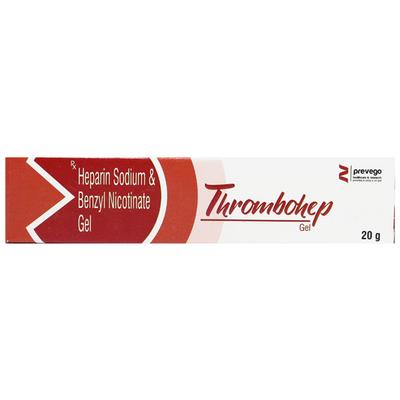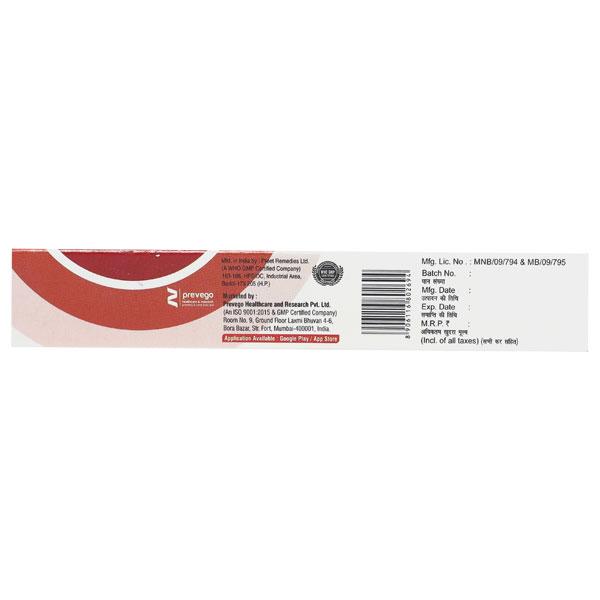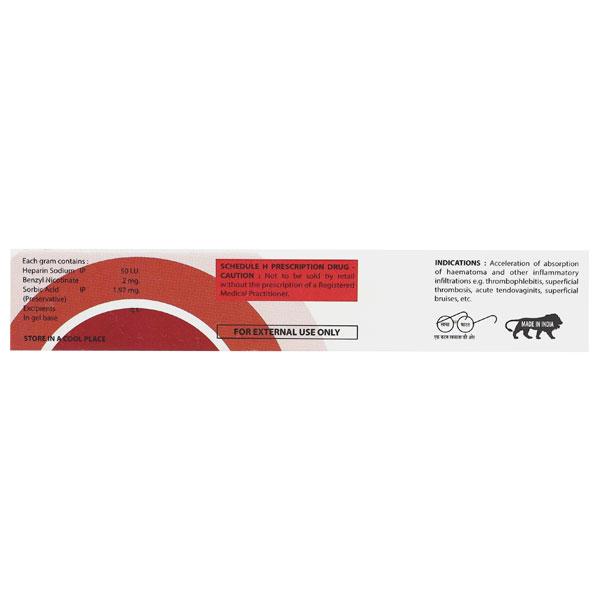

Netmeds First Membership
Quick Links
Introduction About THROMBOHEP GEL
THROMBOHEP GEL contains Heparin which belongs to the group of medicines called Anticoagulants. It is used to manage varicose syndromes and their complications, phlebothrombosis (blood clot in veins), thrombophlebitis (inflammation of a vein due to blood clot), superficial periphlebitis (inflammation of the superficial veins), varicose ulcers, post-surgical varicose veins, after saphenectomy (removal of a damaged vein).
THROMBOHEP GEL can also be used in traumas and injuries, localized oedemas, subcutaneous hematoma (collection of blood under the skin) alone or in combination with systemic therapy.
A blood clot or thrombus is a gel-like collection of blood that form in arteries or veins when blood changes from liquid to partially solid form. Your doctor might want you to take certain blood tests prior to the management.
Before applying THROMBOHEP GEL inform your doctor if you have bleeding, open wounds or mucosae, sites of infection, or hemorrhagic phenomena (excessive bleeding). There is a lack of data on the use of THROMBOHEP GEL in pregnant and breastfeeding women. Consult with your doctor before using.
THROMBOHEP GEL is not recommended for use in children and adolescents below 18 years of age. The most common side effects of applying THROMBOHEP GEL are burning, redness, itching and irritation at application site. Consult your doctor if symptoms do not show improvement.
Uses Of THROMBOHEP GEL
Manages,
- varicose syndromes and their complications, varicose ulcers
- phlebothrombosis (blood clot in veins of the leg)
- thrombophlebitis (inflammation of a vein in the leg)
- post-surgical varicose veins
- saphenectomy (removal of a damaged vein)
- traumas and injuries
- localized oedemas
- subcutaneous hematoma (collection of blood under the skin)
How THROMBOHEP GEL Works
THROMBOHEP GEL binds to the antithrombin (an enzyme present in the clotting system) which in turn inhibits several clotting factors such as factor Xa, factor IIa. This inactivation of thrombin manages the formation of clots and prolongs the clotting time of blood.
How to use THROMBOHEP GEL
Apply THROMBOHEP GEL as advised by your physician. It is for external use only. Apply the medicine to the affected area and massage gently. Wash your hands before and after the application of the medicine. Your doctor will decide the right dose and duration depending on your age, body weight and disease condition.
Side Effects Of THROMBOHEP GEL
Common
- skin rashes
- redness
- itching and burning sensation on the skin
- rough patches on the skin
Rare
Stop applying THROMBOHEP GEL and contact your doctor immediately if you experience any of the following side effects:
- sensitization phenomenon (repeated exposure to the same drug increases specific behavioural, physiological responses to it)
How To Manage Side Effects
Itchy skin:
Hot water makes your skin irritated, so avoid taking hot showers. Do not scratch the affected area. Use sunscreen and protective clothing when outdoors. To soothe and hydrate irritated skin, apply moisturizers. Contact your doctor if the itching worsens.
Warning & Precautions
Pregnancy
There is a lack of data on the use of THROMBOHEP GEL in pregnant women. Consult with your doctor before using.
Breastfeeding
There is a lack of data on the use of THROMBOHEP GEL in breastfeeding women. Consult with your doctor before using.
Driving and Using Machines
THROMBOHEP GEL does not affect your ability to drive or use machines.
Allergy
Do not apply THROMBOHEP GEL if you are allergic to Heparin or any other ingredients of this medicine.
Others
THROMBOHEP GEL is not recommended for use if you:
- have hypersensitivity to the medicine
Before applying THROMBOHEP GEL, inform your doctor if you have:
- bleeding, open wounds or mucosae
- sites of infection
- hemorrhagic phenomena (excessive bleeding)
Use in pediatrics:
THROMBOHEP GELis not recommended for use in children and adolescents below 18 years of age as safety and effectiveness have not been established yet. Consult with your child’s doctor before using THROMBOHEP GEL for your child.
Use in geriatrics:
There is no information the use of THROMBOHEP GEL in elderly patients. Ask for your doctor’s advice before using.
Interactions
A. Drug - Drug interactions:
Before applying THROMBOHEP GEL, inform your doctor if you are taking any of the following medicine:
- other oral anticoagulants used to manage blood clots (Ex. warfarin)
Overdosage:
If you or anyone else accidentally ingests or applies too much of THROMBOHEP GEL, consult your doctor immediately or visit the nearby hospital.
Synopsis
| Drug | : | Heparin |
| Pharmacological Category | : | Anticoagulant |
| Therapeutic Indication | : | Blood clots |
| Dosage Forms | : | Gel, Injection, Solution, Topical solution |
More Information
- Keep THROMBOHEP GEL out of reach of children\
- Store THROMBOHEP GEL at room temperature below 25°C
FAQs About THROMBOHEP GEL
Can THROMBOHEP GEL be used in children?
THROMBOHEP GELis not recommended for use in children and adolescents below 18 years of age as safety and effectiveness have not been established yet. Consult your child’s doctor before using THROMBOHEP GEL for your child.
What is THROMBOHEP GEL used for?
THROMBOHEP GEL is used to manage varicose syndromes and their complications, blood clots in veins of the leg, inflammation of veins in the leg, varicose ulcers, post-surgical varicose veins, after removal of the damaged vein, traumas and injuries, localized oedemas, subcutaneous hematoma
Can THROMBOHEP GEL be used in pregnant women?
Inform your doctor if you are pregnant or planning to have a baby before applying THROMBOHEP GELas safety and effectiveness has not been established yet. Consult your doctor before applying it.
Can THROMBOHEP GEL cause any side effects?
THROMBOHEP GEL can cause itching, burning, redness and irritation at the application site in certain patients. Consult your doctor if the symptoms worsen
How does THROMBOHEP GEL work?
THROMBOHEP GEL binds to the antithrombin which in turn inhibits several clotting factors (factor Xa, factor IIa). Thus, by inactivating the thrombin it manages the formation of clots and prolongs the clotting time of blood.
References
1. KD Tripathi. Drugs Affecting Coagulation, Bleeding and Thrombosis. Essentials of medical pharmacology. Eighth Edition. 2019. Page –663-664.
2. Vikas Saini, Tanvir Samra, Nitin Ahuja, Sameer Sethi. A prospective randomized study to evaluate safety and efficacy of heparin topical solution (1000 IU/ml) compared to heparin topical gel (200 IU/g) in prevention of infusion-associated phlebitis. NIH National Library of Medicine, National Centre for Biotechnology Information. Pubmed Central. November 2018. [Accessed on 11th August 2022]. https://www.ncbi.nlm.nih.gov/pmc/articles/PMC6364337/
3. Cesare Vecchio, Anna Frisinghelli. Topically applied heparins for the treatment of vascular disorders: a comprehensive review. NIH National Library of Medicine, National Centre for Biotechnology Information. Pubmed.govl.. [Accessed on 11th August 2022]. https://pubmed.ncbi.nlm.nih.gov/18783299/
4. A.Menarini Manufacturing Logistics and Services s. r.l. Heparin. [Revised in April 2022] [Accessed on 11th August 2022] https://myhealthbox.eu/en/view/1713833/12bf9dc32c5347af6f251ea29579737d/leaflet
5. Prevago Healthcare. Thrombohep Gel (Heparin). [Accessed on 11th August 2022]. https://www.prevegohealthcare.com/product-page/thrombohep-gel
6. Leeford Healthcare. Aparin (Heparin). [Accessed on 11th August 2022]. https://www.leeford.in/product/1244/aparin
7. Heparin. Central Drugs Standard Control Organisation (CDSCO). [Accessed on 11th August 2022] https://cdscoonline.gov.in/CDSCO/Drugs
Drug bank. Heparin. [Accessed on 11th August 2022]. https://go.drugbank.com/drugs/DB01109
Useful Diagnostic Tests
- Blood tests
- Prothrombin Time










